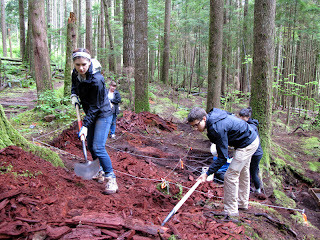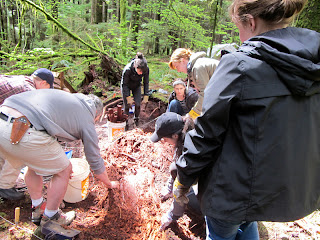Day 9...the sun is still shining and we're back in the dirt...where the findings are good! We came across a number of new artifacts including more ceramics, glass beer bottles (a few even in one piece!), medicine bottles, a coin and lots of bits of tin cans. Spencer K. was on scene again with us today, helping us with his expertise on cans and bottles. I learned (the hard way) how not to get excited and just start pulling out an artifact when you find one. Recording artifacts in situ (as they appear in the ground) and removing the entire level of sediment around them is key...you can't learn anything about the artifacts if you aren't thinking about where exactly you found them. I also learned that no one likes the job of sifting dirt and I think a game of rock paper scissors might be in order to determine sift duty next week.

Roll call: Kitty, Andrew, Jasmin, Rebecca, Dini, Meghan, Evan and myself. Kitty and I were working on the unit that hadn't been started yet. It's pretty exciting when you actually start to get down to the dirt and expose artifacts.
Spencer M. found this medicine bottle intact. Bob thinks that the area Spencer found this bottle in is a place where a cabin used to be, hence the personal items found there like this one.
Rocks get in the way sometimes. Nature can be a challenge when your aim is to uncover evidence of culture. But, we just slowly work around roots, rocks, and logs until we get low enough to remove them out of the way.
Look what I happened to stumble upon today: it's a piece of a Japanese rice bowl. How do I know? It says 'made in Japan' on the bottom. Bob mentioned that any ceramics that are Japanese in origin but have English writing on them, are most likely to have been made after 1920. Prior to that time, the writing would be in Japanese for the most part.
We paused to pose for this shot. Mark has been super on top of taking the photos for the Field School. I brought a fancy camera to the site today and took some pictures...but even with a fine piece of equipment (thanks for lending to me, little brother!) I still am less than amateur at photography. Mark is a super star and always manages to capture all of our best angles.
Evan and Meghan were working on this unit in the "refuse" area today. They found quite a few tin cans intact (very rare to find, cans break down really easily) and some glass bottles. Note how they left the cans in place as they dug down? That's good archaeology. No pot hunting going on here, strictly professional.
Root clippers = an archaeologist's best tool when working in the LSCR forest. A trowel can only do so much when you're digging in dirt infiltrated by a network of tiny, but strong roots. The bad news for nature is that archaeology is destructive in the sense that you have to force your way through vegetation to find anything. Sorry nature, it's in the name of science and education.
Oh hi, Mark. What you got there? A tiny intact blue medicine bottle with Japanese (we think) writing on it? Makes you wonder why someone would throw away a nifty little bottle like that a hundred years ago.
Alexis, Ryan, Spencer and Lindsay working a little further up the path today where they found a coin. Not quite sure on the details of it, but I'll see if I can snag a photo to post. They later moved some of those giant logs behind them to continue excavating...strong lads, I wonder if they'll find anything underneath them.
Here's Lindsay working under/around this log. Sometimes, when the log or rock is just too big, you have to do your best to dig with it in the way. Kitty and I were lucky as the log we had to dig around was rotted and fell apart pretty easily. It was actually underneath the standing and fallen trees that we found most of the artifacts today.
Andrew is holding up another piece of ceramic Japanese rice bowl that we found today. Our guess is that the area that we found this piece in was a kind of trash dump for the kitchen refuse of the camp back in the early 1900's. Yes, us archaeologists love digging through peoples' garbage for information.
So the second week of field work comes to an end. I don't know exactly how to describe just how much fun we're having despite working all day in the dirt. I can't wait to see what our findings can tell us about the people living in this area a hundred years ago. Tomorrow is back in the lab for the crew...hopefully we will get to have a closer look at the artifacts we found.

























































